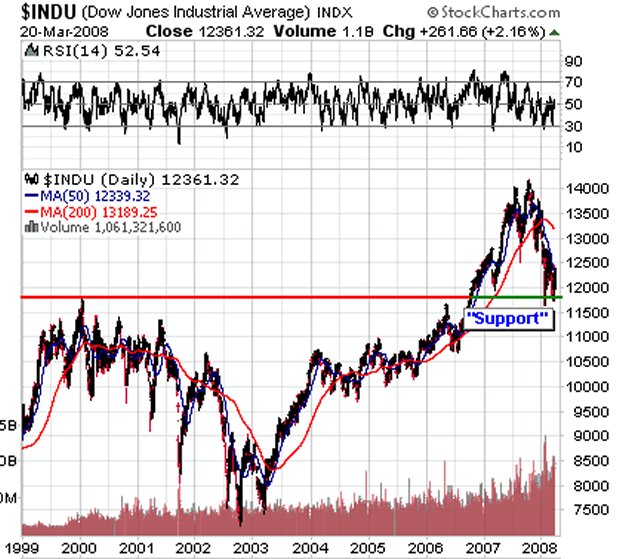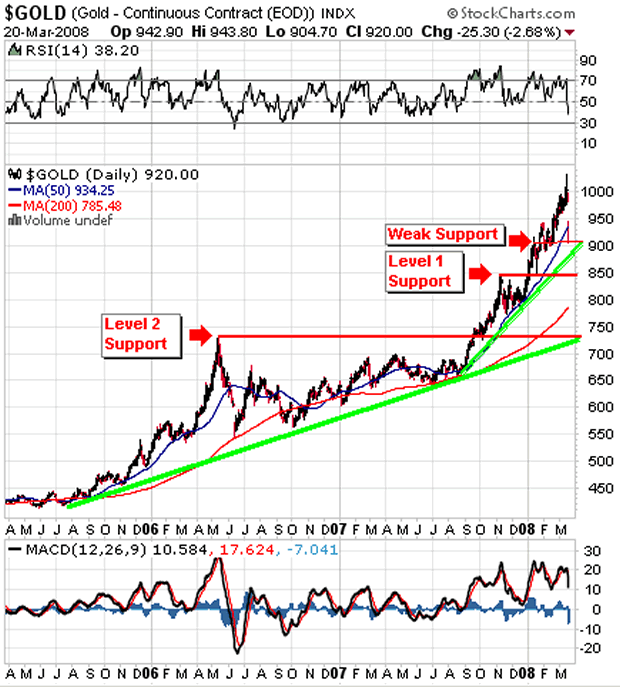The US Fed Engineered Commodities Price Plunge
Commodities / Gold & Silver Mar 22, 2008 - 02:16 PM GMTBy: Alex_Wallenwein
 The world-wide fiat system functions like a roach motel: Investors check in - but they NEVER check out! By it's latest hit on commodities, the Fed as the system-leader gave investors a shot across the bow. The message: "If you try to leave, we will hurt you!"
The world-wide fiat system functions like a roach motel: Investors check in - but they NEVER check out! By it's latest hit on commodities, the Fed as the system-leader gave investors a shot across the bow. The message: "If you try to leave, we will hurt you!"
("Leaving the fiat system" here means to store your wealth in more tangible forms that are not as susceptible to engineered currency collapses.)
Well, wasn't that just too neat?
JP Morgan Chase got to buy its long-time competitor Bear Stearns at less than ten cents on the dollar, even at Bear's super-low share price of the previous trading day (while the JPM co-owned Fed itself supplies 30 billion USD by "loan" to bolster Bear's balance sheet), and suddenly everything turns around. Stocks are up, the markets calm down, and even the commodities decline. Wow!
If all of the commodities sag at the same time, then at least nobody can reasonably accuse anyone of "gold manipulation", can they?
Well, maybe it wasn't gold manipulation, but something surely doesn't smell right (sniff, sniff...)
Ask yourself: has anything fundamentally changed in the markets to cause this across-the-board commodities sell-off? Let's see:
- Mortgages are still toxic, they are still on every US bank's balance sheet or tucked away in off-balance sheet SPVs and other "conduits".
- Banks are still loathe to lend money to each other because they all know how polluted the other's asset positions are (all they have to do is look at their own balance sheet and remember how it got there).
- The economic outlook hasn't changed and home prices are not improving any, so homeowners are still going to default on mortgages like they've been doing. Result: mortgages are still as toxic as they were before. Even the "AAA-rated" top-grade ones.
- Persian Gulf nations are still under enormous pressure to go off their dollar-pegs because their inflation figures simply do not allow them to follow the Fed's successive interest-rate cliff jumps.
- The US economy is still in recession by all ascertainable data, and it doesn't look like that's going to change anytime soon.
- Foreigners have stopped buying long term US treasuries as shown in last week's 10-year note auction (down to under 6 from previously 25%). Yet, treasury prices are still going up (so who on earth is doing the buying, hmm?)
- There are still way too many dollars in the world.
- There is still way to much other fiat currency in the world.
- Ben Bernanke is still the chairman of the US Fed.
- Bush is still in office.
- Euro-zone inflation is still above three percent.
This list could be longer, but we'll stop here to preserve precious cyberspace.
Here is another ground for suspicion: Sunday's mega-intervention was done right at the point where the Dow hit theoretical support from its 2000 high at 11,750, to create the impression among investors that this technical level has "held" and that the ensuing rally could be for real. Hope springs eternal, you know.

Yet, investors, - especially institutional ones – are acting as if all of these negative factors have simply disappeared as a result of the Fed's "magic."
Let's take a good look at what the Fed really did:
Actual Fed Actions:
- In December, it instituted its series of "Term Auction Facility" (TAF) by which it auctioned off 28-day cash loans to banks at preferred lending rates;
- It cut rates at breakneck speed, reducing the federal funds target rate from 5.25 to now 2.25 percent in under seven months;
- In March, it instituted the new "Term Securities Lending Facility" (TSLF), by which it loaned US treasuries from its balance sheets to broker-dealers of treasuries (i.e., big banks only) for 28-day terms and took their mortgage-slime onto its own balance sheet.
- It did an overnight, over-the-weekend emergency cut of the discount rate (the rate at which banks can borrow from the Fed overnight) by 25 basis points.
- Finally, it loaned $30 billion to Bear Stearns while taking Bear's mortgage-slime onto its own balance sheet, also overnight/over the weekend, ostensibly to "stabilize" Bear's balance sheet while getting JP Morgan Chase to offer a paltry, ridiculous $2 per share on stock that on the Friday before still traded for $30per share.
Mind you, all of this Fed lending is really no more than that: lending!
What good does it do a big broker-dealer bank to carry borrowed treasuries on its balance sheet? If it needs to borrow money in the short term market, which potential creditor-bank would be dumb enough to think that just because the borrowing bank now has Fed-loaned treasuries on its balance sheet instead of its own mortgage slime, the borrowing bank is now a "better credit risk"?
It makes absolutely no sense - unless all of this is done with the tacit understanding that the Fed's loan of "prime for slime" is intended to be permanent, or at least nearly so until this entire mess blows over.
So, why did the commodities begin to sell off right at the time the Fed's sale of Bear Stearns to JP Morgan Chase was announced? And why did the dollar bounce at that very moment?
Well, the commodities sold off because the dollar bounced. Commodities are still mainly traded in dollar terms around the world.
Why Did the Dollar Bounce?
One piece in the puzzle may well be the following blog entry recounting what the ECB's Bini Smaghi was quoted as saying by Dennis Gartmann.
"The author of The Gartman Letter referred to comments made by ECB executive board member Bini Smaghi in September, when he detailed how such an intervention could play out:- Step One: Monitoring and assessing exchange rate markets and developments, with a focus on underlying fundamentals.
- Step Two: Discussing these developments with other major players to assess currency developments and policies.
- Step Three: Making public statements on the situation.
- Step Four: Intervening in the foreign exchange markets.
Since verbal interventions have already begun, we are between steps three and four, with actual interventions due next, Mr. Gartman said. Mr. Smaghi has set the table for central banks and their governments around the world, he added."
In other words, the dollar bounced for the sole reason that the Fed and the rest of the world finally performed what is known as a currency intervention. The other central banks agreed to buy dollars. Nothing new, here.
Everything Is Still the Same
The end result of all of the above is that nothing has really changed – except for the thus-far undisclosed international dollar-support action. Other than that, everything is still the same.
So, what was the real point of these actions? If the only change that has any kind of teeth was the coordinated dollar-support action, why did the world's central banks not disclose that?
Answer: Because everybody knows that such action would prop up the dollar and probably result in a correction in the commodities markets. Under those conditions, the battered US Fed would not be able to stand there and accept the adulation of the cheering masses as the "hero who saved the markets."
It's a con-man's trick, through and through.
The dollar's short-term reversal is being pointed to as proof that the Fed's actions "saved the day" while in truth it was the otherwise typical, very un-dramatic, and common-sense currency intervention that did the job. At the same time, one of the Fed's owner banks was able to buy up a competitor at fire-sale prices while benefiting from Fed-injected taxpayer money (i.e., the $30 billion "loaned" to Bear Stern's balance sheet).
The self-defecating, bootlicking, sycophantic financial press hails this as the next best thing to Jesus' second coming, of course. More sober observers can only shake their head at the gullibility of consumers of what goes under the name of "financial news."
Has Gold Topped Out?
Doubtlessly, it eventually will, but we aren't even close yet. Has it corrected? No doubt about that, as well. Can it drop further form here? Sure I actually expected gold to drop back to $750 when it became clear the Indians were selling theirs to buy paper stocks. Occurrences since then made me revise that estimate upward somewhat, to the vicinity around $850.
If gold dropped that far, I would not be surprised in the least – but that is a far cry from "the end" of this gold bull market, as the following chart shows:

The stronger "Level 1" Support is at $850, the level of the November 2007 short-term top that is nominally equal to the 1980 blow-off top.
"Level 2" Support lies at $725, the 2006 interim high, which also coincides with where the green Phase II uptrend line hits the right wall.
In fact, "the end" of this bull market would have to take us all the way back to below $550, which is where the uptrend line from 2001 would hit the right wall, were we to bother drawing it.
Just look past the smoke, break some of the mirrors, and reality looks exactly the way it did before Bernie staged this rehabilitation of the Fed's image as an institution that can "save" the markets.
Of course, none of this even addresses the issue of what ultimate effect yet another rescue action really has on the economy. It can only make things worse in the long run – and that's what the Fed's real raison d'etre seems to be:
Destroy the world's largest, most powerful economy so the US can be "integrated" with other nations in the western hemisphere – but do it slowly, so nobody can point the finger at one particular Fed action and go lynch the bastards. In other words: plausible deniability. That way, at least, that pesky thing called a "Constitutions" that some hopelessly backwards Americans still believe in no longer needs to be paid lip service to.
At least, that appears to be the plan.
Got gold?
Alex Wallenwein
Editor, Publisher
The EURO VS DOLLAR MONITOR
Copyright © 2008 Alex Wallenwein - All Rights Reserved
Alex holds a B.A. degree in Economics and a juris doctorate in Law. His forte is research. In late 1996, he began to research how money is used by some to exert political and economic control over others' lives. In the process, he discovered that gold (along with silver) is the common man's antidote to this effort. In writing and publishing the Euro vs Dollar Monitor, he explains the dynamics of this process and how individuals can harness the power of gold in their efforts to regain their political and financial autonomy.
Just like driving your car, investing only makes sense if you can see where you are going. The Euro vs Dollar Monitor is the golden windshield wiper that removes the media's greasy film of financial misinformation from your investment outlook. Don't drive your investment vehicle without it!
Alex Wallenwein Archive |
© 2005-2022 http://www.MarketOracle.co.uk - The Market Oracle is a FREE Daily Financial Markets Analysis & Forecasting online publication.



